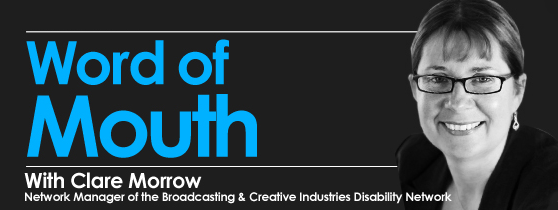
I’ve been banging on about this for years. If 1 in 5 of us is disabled why are there so few disabled people on the telly? And even fewer making our programmes? I guess the two things are almost certainly connected.
Yes I know there’s the argument that you can’t see lots of disabilities so there are alot more disabled people ON telly and IN telly than you think, and that’s probably true. But I doubt either figure gets anywhere near the level you’d expect if TV was reflecting real life, as many of us programme makers like to think it does.
Researchers recently took a snapshot of three weeks of programming across British TV. Against the 20% of the real population with a disability, only 0.9% of people in TV land had one. Not good. The current data suggests that disabled people make up only 2% of the TV industry workforce. Not much better.
Actually, I think we’ve come quite a long way in terms of portrayal, despite what this latest survey found in its snapshot. All the main UK soaps have at least one regular disabled character played by a disabled actor, and that’s a huge step forward which can’t be underestimated in terms of its power to change perceptions in the TV world and the real world. Long running characters give a chance to see people as properly rounded, warts and all, and not just as heroes or people triumphing over tragedy. They’re even allowed to be unpleasant or unpopular. In fact, their disability sometimes doesn’t play much of a part in their storylines.
There’ve been some great creative ideas where disability has been the focus, but in new and unexpected ways. Take Channel 4’s Cast Offs, the BBC’s Britain’s Missing Top Model or Gok’s How to Look Good Naked With a Difference.
We’re also starting to see people appearing much more on shows where their disability isn’t the story at all. There’s been the odd quiz show contestant who’s deaf or uses a wheelchair, we watched a choir whose members all had disabilities battle it out in Last Choir Standing, and Wife Swap featured a blind mum looking after her home and family just like anyone else.
It’s all progress, but we’re still a long way from a TV world where disability is unremarkable, sometimes the story, but mostly just there in the mix, as it is in life.
The key to getting that right, almost certainly, is having more disabled people in our programme teams. Not to make programmes about disability, but to bring their particular production talents alongside their perspective as a disabled person, and their passion for cricket or cooking or whatever.
It’s not going to be easy to achieve. Disabled people aren’t exactly queuing up in their thousands to get into TV, and given that they are only just becoming part of the on screen telly family, maybe that’s not surprising.
The small numbers of successful disabled people working in TV production are still pretty much trailblazers, but we do have a growing pool of new talent coming in behind them, thanks to work done by some broadcasters and indies to encourage disabled people into the industry and give them the skills they need to get started.
Collectively we need to nurture and develop them to make sure they get the opportunity to succeed.
The most creative production teams are made up of people who all bring different skills and life experiences to the table. Different voices make for good ideas and unexpected angles, and at the moment there is a significant voice missing on most productions.
Clare Morrow, is the Network Manager of the Broadcasting and Creative Industries Disability Network. She is the former Controller of News and Regional Programmes for ITV Yorkshire.